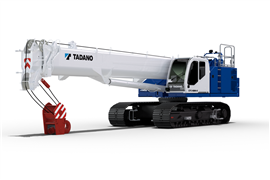Flexible handling
01 May 2008
Annual sales of telescopic material handlers are hovering around the 8,000 mark, almost half the historical peak of 15,000 units. Dominating the sector is JLG, which owns the leading brands, Lull and Skytrak, following its deal with previous owner Omniquip. At the time of the purchase, it also already owned the Gradall product line and also had its own JLG branded machines. Next come Cat and JCB and then Terex, Pettibone and the others.
The US market has traditionally favored a high boom pivot design, to allow the operator to look below the boom when traveling with the boom in the horizontal position–so much so in fact that JCB, one European manufacturer that has attempted to penetrate the market, felt it necessary to develop such designs to ofer alongside the low boom design machines that it has traditionally manufactured for European customers. It has, therefore, been selling two distinct designs in the US for years.
Things appear to be changing, in part because of acquisitions and other tie–ups between US–based companies and their European counterparts. As a result, low boom pivot point variants are now available from most if not all the major manufacturers.
Meeting needs
Among other market drivers, key are two that are worthy of particular note–the need for machines designed to work in confined spaces, and, at the other end of the scale, a need for ever greater capacity, higher lift machines. Th ese needs are, therefore, pushing manufacturers into supplying a full line of equipment, filling the gaps in their product lines and developing new machines.
Manitou and Gehl are a case in point. To supply just such a full line, the two firms signed an agreement in March 2004. Th is allows the latter to sell certain Manitou machines, painted and badged as Gehl, as well as allowing the two to cross–market each other's machines.
This does not mean that their individual product development has stopped, however. Manitou recently launched the MLT627 compact unit. An update of the MLT526, the new machine is now powered by a Tier II Perkins diesel engine and ofers a maximum capacity of 6,000 pounds and a maximum lift height of 18 feet.
Gehl in its turn has introduced five new CT–Series telescopic handlers–the CT5–16, CT5–16 Turbo, CT6–18 Low Profle, CT6–18 Turbo, and CT7–23 Turbo. These compact machines range in maximum capacity from 5,000 to 7,000 pounds, maximum lift heights from 16 to 22.5 feet and in rated capacity from 5,000 to 6,000 pounds. Turbocharged and naturally aspirated diesel engines range from 58 to 101 hp (43 to 75 kW) and comply with EPA Tier II regulations.
Terex is another supplier of certain European models, in the shape of two compact telehandlers from Italian subsidiary Terex Lift, which provides its own existing US range with greater coverage in the compact machine class.
Caterpillar, towards the end of last year, added telehandlers at both ends of the product line, with two compact machines and a high reach heavy lift machine. The TH210 and TH215 are both low boom pivot designs, and can carry 4,850 and 5,500 pounds, respectively. The 210 has a maximum lift height of 17 feet and the 215 lifts to a maximum of just over 18 feet. The largest of Caterpillar's B–Series is the TH580B that can lift loads up to 56 feet using its four–section boom, while its rated load capacity is 11,000 pounds.
Special design
Some of the machines on ofer have particularly distinctive design features. Both Pettibone and Lull produce telehandlers with a traversing boom. Th is concept allows the boom to move forward and back on the telehandler's chassis, allowing loads to be accurately placed through openings and on scaffolding.
The latest of these models from Pettibone is the Traverse T8044 with a lift capacity of 8,000 pounds and a lift height of 44 feet. On this model, the traversing boom can travel almost 6 feet forward or back on the chassis. Designed to be as low as possible, the machine cannot under an 8 foot doorway.
JLG has another unique machine in the shape of its Transformer, which lifts 6,600 pounds and has a maximum lift height of 42 feet. What is unique is the ability it offers for the forks to be replaced by a personnel act basket, in minutes the manufacturer claims, to allow the machine to double up as an aerial work platform, fully controllable and driveable from the basket, with a maximum capacity of 1,000 pounds. Th is capability does not come cheap because additional control system elements are required that add cost.
With the flexibility and maneuverability they offer, telehandlers are set to continue to be popular solutions for the movement of materials on construction sites. As further compact machines enter the market, and as capacities and lift heights grow to new heights at the heavy end, users can be more sure than ever that there is a solution available that will meet their needs.
STAY CONNECTED


Receive the information you need when you need it through our world-leading magazines, newsletters and daily briefings.
CONNECT WITH THE TEAM











